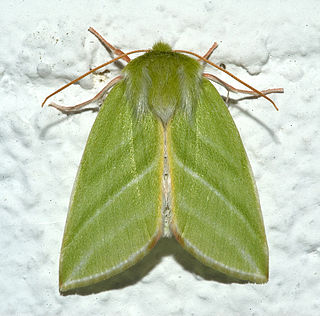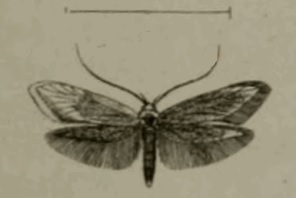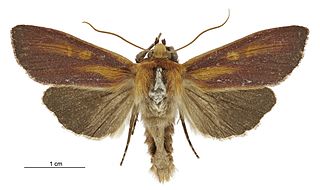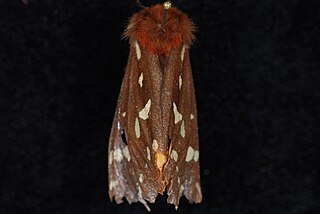
Nolidae is a family of moths with about 1,700 described species worldwide. They are mostly small with dull coloration, the main distinguishing feature being a silk cocoon with a vertical exit slit. The group is sometimes known as tuft moths, after the tufts of raised scales on the forewings of two subfamilies, Nolinae and Collomeninae. The larvae also tend to have muted colors and tufts of short hairs.

Lobesia botrana, the European grapevine moth or European grape worm, is a moth of the family Tortricidae.

Arctia virginalis, the Ranchman's tiger moth, is a species of tiger moth in the family Erebidae. It was first described by Jean Baptiste Boisduval in 1852.
Perittia passula is a moth of the family Elachistidae. It is found in California, United States.
Coelopoeta is a relatively divergent genus of small moths in the superfamily Gelechioidea, which have only been found in western North America.
Coelopoeta glutinosi is a tiny species of moth in the superfamily Gelechioidea. It is found in California in the United States.
Coelopoeta maiadella is a moth in the superfamily Gelechioidea. It is found in Yukon, Canada.

Syringopais temperatella, the cereal leaf miner or wheat leaf miner, is a very small sized moth of the family Pterolonchidae. It is found on Cyprus and in Greece and the Near East. It is an important pest in cereal grain fields in some areas.

Ichneutica purdii, the orange astelia wainscot, is a moth of the family Noctuidae. It is endemic to New Zealand. It can be found throughout the main islands of New Zealand. I. purdii is a relatively large, colourful moth, unlikely to be confused with any other endemic moth species in New Zealand. The larvae of this moth feed at night on species of Astelia. During the day they shelter in the interior of the plant. When fully grown the larvae can reach a length of approximately 48mm. The larvae are ocherous in colour with a pink flush with line markings but when ready to pupate these markings fade and the larvae take on a light golden hue with a rosy tinge to its rear segments. The deep wine coloured pupa is enclosed in a slight cocoon, with this being constructed below the soil, amongst debris or alternatively within a hollow stick. The adult moths are on the wing from October to March. Although this moth is found throughout the main islands of New Zealand it is more frequent in the south of New Zealand at higher altitudes of up to 1200m.
Apantesis allectans is a moth of the family Erebidae. It was described by Douglas C. Ferguson in 1985. It is found in the Mexican states of Durango and Sonora and the Chiricahua Mountains of southern Arizona in the United States. The habitat consists of open montane pine forests.

Apantesis anna, the Anna tiger moth, is a moth of the family Erebidae. It was described by Augustus Radcliffe Grote in 1863. It is found from Maine to the mountains of North Carolina, west to Nebraska and Arkansas.
Apantesis doris, the Doris tiger moth, is a moth of the family Erebidae. It was described by Jean Baptiste Boisduval in 1869. It is found in North America from British Columbia, northern Idaho, Alberta and western Montana. In the east, it is found in the Atlantic Coast provinces and from Nova Scotia to northern Florida and west to central Texas. The habitat consists of open willow/sedge fens and probably other open wetlands in the boreal forest.
Apantesis williamsii, or Williams' tiger moth, is a moth of the family Erebidae. It was described by Charles R. Dodge in 1871. It is found in North America from the Northwest Territories east to the northern Great Lakes region, New Brunswick and New England. It also occurs throughout the northern Great Plains, south at higher elevations to Arizona and New Mexico, west to south-eastern British Columbia and eastern California.
Apantesis arizoniensis is a moth of the family Erebidae. It was described by Robert Harper Stretch (1837–1926) in 1874. It is found from the southwestern United States to Colombia. In the United States, it has been recorded from California, east to western Texas and north to western Colorado and western Wyoming.

Apantesis proxima, the Mexican tiger moth, is a moth of the family Erebidae. It was described by Felix Guérin-Méneville in 1844.
Arctia yarrowii, or Yarrow's tiger moth, is a moth of the family Erebidae. It was described by Richard Harper Stretch in 1874. It is found in North America from Hudson Bay to British Columbia and northern Arizona. The habitat consists of barren rocky fellfields and slides above the timberline. These moths are also found in the Pacific Northwest.

Arctia parthenos, the St. Lawrence tiger moth, is a moth in the family Erebidae. It was described by Thaddeus William Harris in 1850. It is found in boreal North America, ranging from Alaska to Labrador, south to New Mexico and Arizona in the Rocky Mountains and to North Carolina in the Appalachian Mountains. The habitat consists of riparian areas and mixed hardwood-conifer forests at middle to high elevations.

Elachista eurychora is a species of moth in the family Elachistidae. This species is endemic to New Zealand and has only been collected at Paekākāriki. The habitat where the adult moth was originally collected was in rough vegetation on coastal sandhills or dunes but the collection locality has been significantly modified since that time. It has been hypothesised that the host of the larvae of this species is a grass. Adults are on the wing in March. It is classified as "Data Deficient" by the Department of Conservation.
Gynaephora rossii, in English known as Ross' tussock moth, is a species of tussock moth in the family Erebidae. It is widespread in the tundras and highlands of the Holarctic. It has large, furry caterpillars which seem to eat mostly saxifrages.

Zapyrastra stellata is a species of moth of the family Momphidae first described by Alfred Philpott in 1931. It is endemic to New Zealand and has been observed in Otago. The larvae of this species mine the leaves of Meuhlenbeckia. Adults are on the wing in June and December.









